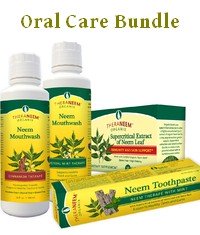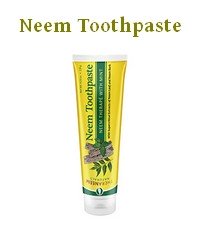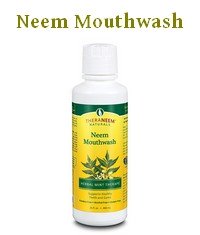Making A Neem Toothbrush
Researchers believe that the use of neem toothbrushes is responsible for the bright smiles and healthy teeth of Indian villagers, people who never had access to any modern dental care facilities, products or fancy toothpaste.
On the page about neem toothpaste I talk more about the impressive results that researchers and individuals had when treating gum disease with neem.
Maybe you already read there, or somewhere else, how Indians traditionally chew on neem twigs to keep their gums and teeth healthy.
Well, there is a bit more to it than just chewing. Here is a more detailed description of how neem twigs rather than neem toothpaste are traditionally used in India.
Making A Neem Toothbrush
For a proper neem toothbrush you need a young, flexible branch of a neem tree, about 15 to 20 cm long, and 15 to 20 mm thick. Such a twig won't have a real bark, just a thin skin. Peel that skin off.
Now chew one end of the stick. All the fibres will separate and the end will turn into a little brush.
The process of chewing the twig is already helpful. It releases the beneficial ingredients in neem that kill harmful bacteria, reduce inflammation, and stop bacteria and plaque from sticking to your teeth.
Using The Neem Toothbrush
Now that brush is used to rub over all the sides of all teeth. Be careful not to injure the gums in the process. This is the part where you actually clean the teeth.
In the end you just spit out all the little bits of neem fibre. It doesn't taste real nice, by the way. Bitter.
The neem toothbrush is disposable, meant to be used only once. After cleaning the teeth the neem stick is split in half, and one end is bent into a U-shape and used as a tongue cleaner.
Removing the soft plaque from the anaerobic back of the tongue also makes a big difference in overall oral hygiene and levels of harmful bacteria, so don't overlook this aspect of using the neem toothbrush.
There you go, that's how you make and use a neem toothbrush the traditional way. I certainly believe that this traditional way of cleaning the teeth and the tongue is as least as effective as our modern methods.
Neem is not the only tree that is used in India for toothbrushes. In fact, different wood is recommended for different types of people and conditions. There is also a caveat: it is not recommended that you use a neem stick like that if you suffer from nausea, indigestion or a cough.
And, if you want to use a neem stick, you are also advised to consult an elder for advice first, or even for a demonstration. It's bit like in our society we say, "always consult a qualified medical practitioner"...
No, I'm not saying you should consult a doctor before you bite into a neem twig. I chew them all the time, so far with no ill effects ever.
But it's always good to remind ourselves that neem is very powerful, that we need to be informed, and that we have to use it responsibly and in moderation.
Now go find a neem stick...
(By the way, though chewing neem sticks is still common in India, most modern Indians simply use neem toothpaste instead.)


